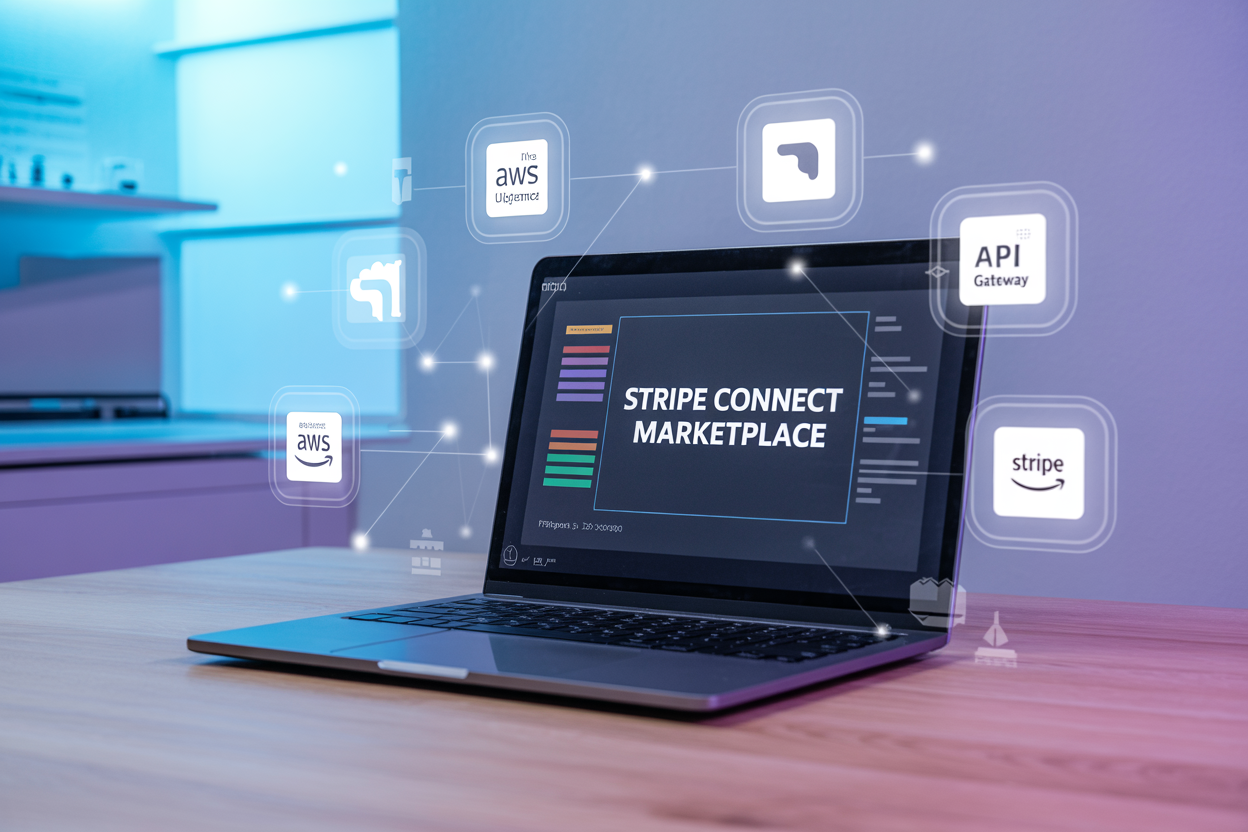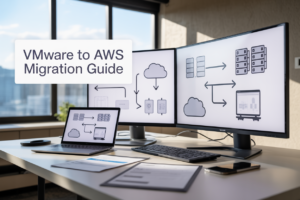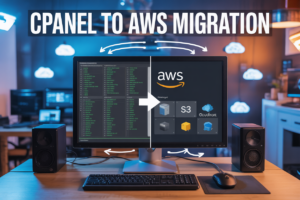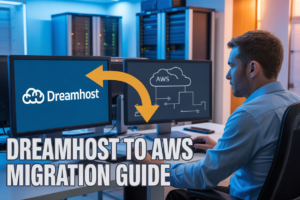Creating a Stripe Connect marketplace on AWS serverless infrastructure lets you build a scalable multi-vendor platform without managing servers. This complete guide is for developers and tech entrepreneurs who want to launch a marketplace that handles complex payment flows while keeping costs low and performance high.
You’ll learn how to design a robust marketplace architecture AWS Lambda that scales automatically with demand. We’ll walk through the entire Stripe Connect integration guide process, from setting up your payment infrastructure to handling multi-party transactions between buyers and sellers.
This guide covers building core marketplace features with AWS Lambda functions that process payments, manage vendor onboarding, and handle dispute resolution. You’ll also master advanced payment workflows including split payments, escrow systems, and automated payouts that make your marketplace profitable for everyone involved.
By the end, you’ll have a production-ready AWS serverless marketplace that can handle thousands of transactions while you focus on growing your business instead of maintaining infrastructure.
Understanding Stripe Connect and Marketplace Fundamentals

Core Benefits of Stripe Connect for Multi-Party Payments
Stripe Connect marketplace solutions transform complex payment splitting into seamless transactions. The platform handles the heavy lifting of routing payments between buyers, sellers, and platform owners while maintaining complete compliance with financial regulations across different regions.
The biggest advantage lies in automated payment distribution. When a customer makes a purchase, Stripe Connect automatically splits the payment according to your predefined rules – sending the seller their portion, deducting platform fees, and handling tax calculations. This eliminates the need for manual payment processing or complex reconciliation systems.
Risk management becomes significantly simpler with Stripe’s built-in fraud detection and dispute handling. The platform monitors transactions for suspicious activity and provides automated responses to chargebacks, protecting both your marketplace and connected sellers from potential losses.
Multi-vendor marketplace development benefits from Stripe’s robust onboarding system. Sellers can complete verification through a streamlined process that includes identity verification, bank account setup, and compliance checks. This reduces friction while ensuring your marketplace meets regulatory requirements.
The platform’s global reach supports payments in 135+ currencies and multiple payment methods, from credit cards to digital wallets. This flexibility allows your marketplace to serve international customers without building separate payment infrastructure for each region.
Essential Marketplace Models and Revenue Streams
Different marketplace architectures require specific payment flow configurations. The commission-based model represents the most common approach, where platforms collect a percentage of each transaction. Stripe Connect handles this through application fees – automatically deducting your commission before transferring funds to sellers.
Subscription marketplaces combine recurring billing with transaction fees. Sellers pay monthly platform fees while customers make individual purchases. Stripe Connect manages both revenue streams simultaneously, tracking subscription states and processing one-time payments within the same infrastructure.
The freemium marketplace model offers basic services free while charging for premium features or higher transaction volumes. This approach works well for service-based platforms where sellers upgrade as their business grows.
Revenue optimization strategies include:
- Dynamic pricing tiers based on seller volume or category
- Enhanced service fees for premium marketplace features
- Cross-border transaction premiums for international sales
- Instant payout charges for sellers wanting immediate access to funds
Marketplace architecture AWS Lambda integration allows for sophisticated revenue calculations. You can implement complex fee structures, promotional discounts, and loyalty programs that adjust commission rates based on seller performance or customer behavior.
Key Technical Requirements and Prerequisites
AWS serverless marketplace development requires specific technical foundations. Start with an AWS account configured for production workloads, including proper IAM roles for Lambda functions, API Gateway endpoints, and DynamoDB table access.
Your development environment needs Node.js or Python runtime for Lambda functions, along with the AWS CLI and Serverless Framework for deployment automation. Stripe Connect integration guide implementation requires API keys for both test and production environments.
Essential AWS services include:
| Service | Purpose | Configuration |
|---|---|---|
| Lambda | Business logic processing | Runtime: Node.js 18.x or Python 3.9+ |
| API Gateway | REST API endpoints | CORS enabled, custom domain |
| DynamoDB | User and transaction data | On-demand billing, global tables |
| S3 | Static asset storage | Public read access, CloudFront integration |
| CloudWatch | Monitoring and logging | Custom metrics, alerts configured |
Database schema planning becomes critical for serverless payment processing. Design tables for users, products, transactions, and webhook events with proper indexes for query performance. DynamoDB’s single-table design works well for marketplace data patterns.
Security requirements include HTTPS enforcement across all endpoints, proper API key management through AWS Secrets Manager, and webhook signature verification for Stripe events. PCI compliance considerations apply even though Stripe handles sensitive payment data.
Marketplace payment workflows demand careful error handling and retry logic. Network failures, payment processing delays, and webhook delivery issues need graceful handling to maintain data consistency across your distributed system.
Testing infrastructure should include separate Stripe test accounts, AWS staging environments, and automated testing pipelines that validate payment flows end-to-end before production deployment.
Planning Your Serverless Marketplace Architecture

AWS Serverless Components for Payment Processing
Building a serverless marketplace architecture on AWS requires selecting the right components to handle payment processing efficiently. AWS Lambda functions serve as the backbone for your marketplace payment workflows, handling everything from payment initiation to webhook processing. These functions can process thousands of concurrent transactions without server management overhead.
API Gateway acts as your marketplace’s front door, managing RESTful endpoints for vendor registration, payment processing, and order management. It integrates seamlessly with Lambda functions and provides built-in throttling to protect your AWS serverless marketplace from traffic spikes.
For data persistence, DynamoDB offers lightning-fast NoSQL storage perfect for transaction records, vendor profiles, and product catalogs. Its auto-scaling capabilities ensure your database grows with your marketplace demands. Amazon S3 handles file storage for vendor documents, product images, and compliance records.
EventBridge orchestrates complex payment workflows by routing events between services. When a customer makes a purchase, EventBridge can trigger multiple Lambda functions to update inventory, send notifications, and process payouts to vendors.
SQS queues handle asynchronous processing for tasks like payment notifications and vendor settlements. This prevents blocking operations and improves your marketplace’s responsiveness during high-traffic periods.
Database Design for Multi-Vendor Transactions
Multi-vendor marketplace development demands careful database design to track complex transaction relationships. Your data model should separate customer orders from individual vendor fulfillments, allowing partial shipments and independent vendor operations.
The core entities include Users (customers and vendors), Products, Orders, and Transactions. Each order can contain items from multiple vendors, requiring order splitting logic. Design your tables to support this hierarchy:
| Entity | Purpose | Key Relationships |
|---|---|---|
| Users | Store customer and vendor profiles | Links to Orders and Products |
| Products | Catalog items with vendor association | Belongs to specific vendor |
| Orders | Customer purchase records | Contains multiple OrderItems |
| OrderItems | Individual product purchases | Links Product to Order |
| Transactions | Payment processing records | Tracks money flow per vendor |
DynamoDB’s partition key strategy becomes critical here. Use composite keys like ORDER#123 and VENDOR#456 to enable efficient queries across vendor boundaries. Global Secondary Indexes help track vendor-specific metrics and customer purchase history.
Consider using DynamoDB Streams to trigger downstream processes when transaction states change. This event-driven approach keeps your serverless payment processing responsive and maintains data consistency across services.
Security Considerations and Compliance Requirements
Security in a Stripe Connect marketplace goes beyond basic SSL certificates. You’re handling sensitive financial data for multiple parties, making compliance non-negotiable. Start with PCI DSS requirements – even though Stripe handles card data, your marketplace must secure customer information and transaction records.
Implement proper IAM roles for each Lambda function, following the principle of least privilege. Payment processing functions should only access payment-related resources, while vendor management functions stay isolated from financial data.
AWS Secrets Manager stores your Stripe API keys securely, rotating them automatically and preventing hardcoded credentials in your code. Use different keys for development and production environments.
Data encryption becomes paramount when dealing with vendor information and transaction records. Enable encryption at rest for DynamoDB tables and S3 buckets. Use AWS KMS for additional key management control.
API authentication requires multiple layers – JWT tokens for user sessions, API keys for vendor integrations, and webhook signature verification for Stripe communications. Rate limiting through API Gateway prevents abuse and ensures fair resource usage across vendors.
Regular security audits and penetration testing help identify vulnerabilities before they become problems. Document your security practices for vendor onboarding and regulatory compliance.
Scalability Planning for Growing Marketplaces
AWS serverless marketplace architecture scales automatically, but planning prevents bottlenecks as your platform grows. Lambda functions scale to 1000 concurrent executions by default, but you can request increases based on projected transaction volumes.
DynamoDB’s on-demand pricing model eliminates capacity planning guesswork, scaling read and write capacity based on actual usage. For predictable workloads, provisioned capacity with auto-scaling offers cost optimization.
Design your marketplace architecture AWS Lambda functions for stateless operation. Store session data in DynamoDB or ElastiCache rather than memory, enabling seamless scaling across availability zones.
Consider implementing caching strategies for frequently accessed data like product catalogs and vendor profiles. CloudFront CDN caches static content globally, reducing load times for customers worldwide.
Monitor key metrics through CloudWatch dashboards – track Lambda execution times, DynamoDB throttling events, and API Gateway error rates. Set up alerts for threshold breaches to catch scaling issues early.
Plan for regional expansion by designing multi-region deployment strategies. Route 53 can direct traffic to the nearest region, while DynamoDB Global Tables replicate data across regions for disaster recovery and performance optimization.
Build your Stripe Connect integration guide with horizontal scaling in mind – use consistent hashing for data distribution and avoid single points of failure in your architecture design.
Setting Up Stripe Connect Integration

Creating and Configuring Stripe Connect Accounts
Before building your Stripe Connect marketplace, you’ll need to set up your platform account and configure the necessary settings. Head to your Stripe Dashboard and navigate to the Connect section to create your first Connect application. This application represents your marketplace platform and acts as the central hub for managing all connected accounts.
During the initial setup, Stripe will ask you to specify your business model. Choose between Standard, Express, or Custom accounts based on your marketplace requirements. Express accounts work well for most AWS serverless marketplace implementations as they provide a good balance between simplicity and customization. Standard accounts offer more flexibility but require additional compliance handling.
Configure your platform settings by defining your marketplace’s branding, including logo, colors, and business information. These details will appear during the vendor onboarding process, so make sure they accurately represent your brand. Set up your redirect URLs to point to your AWS Lambda functions that will handle the OAuth callback responses.
| Account Type | Best For | Compliance | Customization |
|---|---|---|---|
| Express | Most marketplaces | Stripe handles | Moderate |
| Standard | Simple integrations | Minimal | Limited |
| Custom | Full control | You handle | Complete |
Don’t forget to configure your webhook endpoints in the Connect settings. These webhooks will notify your serverless marketplace about important events like account updates, payment completions, and payout status changes.
Implementing OAuth Flow for Vendor Onboarding
The OAuth flow serves as the bridge between your marketplace and vendor accounts, enabling seamless onboarding while maintaining security. Your AWS Lambda functions will orchestrate this process, starting with generating the Connect OAuth link that vendors click to begin registration.
Create a Lambda function that constructs the OAuth URL using Stripe’s authorization endpoint. Include your client ID, redirect URI, and any additional parameters like suggested capabilities or prefilled information. The redirect URI should point to another Lambda function that handles the OAuth callback.
const stripeAuthUrl = `https://connect.stripe.com/oauth/authorize?response_type=code&client_id=${clientId}&scope=read_write&redirect_uri=${redirectUri}&stripe_user[business_type]=${businessType}`;
When vendors complete the Stripe onboarding process, Stripe redirects them back to your callback Lambda function with an authorization code. Exchange this code for an access token and refresh token, then store these credentials securely in your database. Consider using AWS Systems Manager Parameter Store or AWS Secrets Manager for sensitive token storage.
Handle error scenarios gracefully by implementing proper error messaging and retry mechanisms. Vendors might abandon the process or encounter technical issues, so provide clear instructions and alternative onboarding paths. Store partial onboarding data so vendors can resume where they left off.
Your callback Lambda should also trigger any post-onboarding workflows, such as sending welcome emails, updating vendor status in your database, or initiating additional verification processes required by your marketplace policies.
Managing Connected Account Webhooks
Webhook management becomes crucial for maintaining real-time synchronization between your AWS serverless marketplace and Stripe Connect. Set up dedicated Lambda functions to handle different webhook event types, ensuring your marketplace stays updated with account status changes, payment events, and compliance requirements.
Create separate webhook endpoints for different event categories to improve processing efficiency and debugging capabilities. Account-related webhooks should update vendor profiles and onboarding status, while payment webhooks handle transaction confirmations and failure notifications.
Implement proper webhook verification in your Lambda functions to ensure requests actually come from Stripe. Use the webhook signature verification process to validate each incoming request:
const sig = request.headers['stripe-signature'];
const event = stripe.webhooks.constructEvent(request.body, sig, webhookSecret);
Design your webhook handlers to be idempotent since Stripe may send the same webhook multiple times. Store processed webhook IDs in DynamoDB to prevent duplicate processing. Include proper error handling and retry logic for failed webhook processing attempts.
Consider implementing a dead letter queue using Amazon SQS to capture failed webhook events for manual review and reprocessing. This ensures no critical marketplace events get lost due to temporary system issues or processing errors.
Monitor webhook performance using CloudWatch metrics and set up alerts for high failure rates or processing delays. Quick webhook response times are essential for maintaining good standing with Stripe’s webhook delivery system.
Testing Payment Flows in Development Environment
Thorough testing of your Stripe Connect integration prevents costly issues in production and ensures smooth marketplace operations. Stripe provides comprehensive testing tools specifically designed for Connect implementations, including test accounts and simulated payment scenarios.
Create test connected accounts using Stripe’s test mode to simulate different vendor scenarios. Generate accounts with various verification statuses, capabilities, and restrictions to test how your AWS Lambda functions handle different account states. This helps identify edge cases in your marketplace payment workflows.
Use Stripe’s test card numbers to simulate different payment outcomes including successful payments, declined cards, and various error conditions. Test both direct charges and destination charges to ensure your serverless payment processing handles both scenarios correctly.
// Test successful payment
const testCard = '4242424242424242';
// Test declined payment
const declinedCard = '4000000000000002';
// Test insufficient funds
const insufficientFundsCard = '4000000000009995';
Implement automated testing using tools like Jest or Mocha to create comprehensive test suites for your payment flows. Mock Stripe API responses to test your Lambda functions under different conditions without making actual API calls during unit testing.
Set up staging environments that mirror your production AWS serverless architecture but use Stripe’s test mode. This allows end-to-end testing of your marketplace payment workflows including webhook delivery, database updates, and email notifications.
Document your testing procedures and create test scenarios that cover marketplace-specific use cases like split payments, refunds, and payout scheduling. Regular testing prevents regressions when updating your serverless marketplace codebase or Stripe integration components.
Building Core Marketplace Features with AWS Lambda

User Registration and Vendor Onboarding Functions
Creating a seamless user registration system with AWS Lambda starts with building separate functions for buyers and sellers. Your Lambda functions should handle basic user authentication while simultaneously preparing for Stripe Connect integration. When vendors sign up, you’ll want to trigger an onboarding workflow that collects essential business information like tax IDs, bank account details, and identity verification documents.
The vendor onboarding process requires careful orchestration using AWS Step Functions to manage the multi-step verification flow. Your Lambda function should create Stripe Connect accounts programmatically, handling both Standard and Express account types depending on your marketplace model. Here’s where the Stripe Connect marketplace architecture really shines – you can automate most of the compliance and verification processes.
Build dedicated functions for:
- Initial user registration and email verification
- Stripe Connect account creation and linking
- Document upload handling with S3 integration
- Verification status monitoring and updates
- Automated email notifications for onboarding progress
Store user data in DynamoDB with proper indexing for quick lookups. Your AWS Lambda functions should include error handling for failed Stripe API calls and retry mechanisms for network issues. Remember to implement proper validation for all input data and sanitize uploads to prevent security vulnerabilities.
Product Listing and Inventory Management APIs
Your product management system needs robust Lambda functions that can handle high-traffic scenarios typical in serverless marketplace environments. Create RESTful APIs using API Gateway that connect to Lambda functions for all CRUD operations on products. Each vendor should only access their own inventory through proper authorization middleware.
Design your product schema to support marketplace-specific features like:
- Multiple product variants (size, color, price)
- Inventory tracking with low-stock alerts
- Category and tag management
- Image upload and processing with S3 and CloudFront
- SEO-friendly URL generation
- Search indexing for ElasticSearch or DynamoDB
Your inventory management Lambda functions should handle real-time stock updates and prevent overselling through atomic operations. Implement event-driven architecture where product updates trigger notifications to subscribed users or update search indices automatically.
Create separate functions for:
- Product creation and validation
- Bulk product imports via CSV or API
- Image processing and thumbnail generation
- Inventory synchronization with external systems
- Product search and filtering
- Analytics and reporting for vendors
Use DynamoDB Streams to trigger inventory alerts and maintain audit trails for all product changes. This AWS serverless marketplace approach ensures scalability while keeping costs predictable.
Order Processing and Payment Handling Logic
The heart of your marketplace payment workflows lies in the order processing Lambda functions. These functions coordinate between multiple systems: your marketplace database, Stripe Connect for payments, and vendor notification systems. When customers place orders, your Lambda function should create the order record, calculate fees, and initiate the Stripe payment process.
Implement a robust state machine using AWS Step Functions to handle the complete order lifecycle:
| Order Stage | Lambda Function | Stripe Action | Next Step |
|---|---|---|---|
| Order Created | createOrder |
Create Payment Intent | Await Payment |
| Payment Confirmed | processPayment |
Capture Payment | Notify Vendor |
| Order Fulfilled | fulfillOrder |
Transfer to Vendor | Update Status |
| Order Complete | completeOrder |
Release Hold | Send Receipt |
Your payment handling logic should support split payments where the marketplace takes a commission while transferring the remainder to vendors. Use Stripe Connect’s serverless payment processing capabilities to handle complex scenarios like refunds, disputes, and multi-party transactions.
Build Lambda functions that can:
- Calculate dynamic pricing including taxes and fees
- Handle promotional codes and marketplace discounts
- Process refunds with proper vendor notification
- Manage payment disputes and chargebacks
- Generate detailed financial reports for vendors
- Handle failed payments and retry mechanisms
Each function should include comprehensive logging using CloudWatch and proper error handling that gracefully manages payment failures. Your Stripe Connect integration guide implementation should also support webhook processing for real-time payment status updates, ensuring your marketplace stays synchronized with Stripe’s systems at all times.
Implementing Advanced Payment Workflows

Split Payment Distribution Between Parties
Creating a robust payment splitting system forms the backbone of any successful Stripe Connect marketplace. When buyers make purchases, the funds need to flow seamlessly between platform owners, sellers, and any service providers involved. Stripe Connect’s transfer capabilities make this process straightforward while maintaining transparency and control.
The most effective approach involves capturing payments to your platform account first, then distributing funds through separate transfers. This method gives you complete control over timing and allows for fee collection before transferring seller portions. You can implement automatic transfers immediately after payment capture or schedule them based on your business requirements.
// Example: Split payment between platform and seller
const transfer = await stripe.transfers.create({
amount: sellerAmount,
currency: 'usd',
destination: sellerAccountId,
transfer_group: orderId,
});
For complex marketplaces with multiple parties, consider creating transfer groups that link related payments. This helps with tracking and reconciliation when orders involve multiple sellers or service providers. Your AWS Lambda functions can handle these calculations dynamically based on predefined commission structures stored in DynamoDB.
Setting up automated fee calculations ensures consistency across all transactions. Store your fee structures in a configuration table, allowing for easy adjustments without code changes. This flexibility becomes crucial as your marketplace grows and you need to accommodate different seller tiers or promotional periods.
Escrow and Delayed Payment Release Systems
Escrow functionality protects both buyers and sellers by holding funds until specific conditions are met. This feature becomes essential for service-based marketplaces or high-value transactions where delivery confirmation is required before payment release.
Implementing escrow with Stripe Connect involves capturing payments immediately but delaying transfers to connected accounts. Your system needs to track order status and trigger payment release based on predefined criteria. Common triggers include delivery confirmation, service completion, or automatic release after a specified time period.
// Delayed transfer after order fulfillment
const schedulePaymentRelease = async (orderId, delayDays) => {
const scheduleTime = new Date();
scheduleTime.setDate(scheduleTime.getDate() + delayDays);
await eventBridge.putEvents({
Entries: [{
Source: 'marketplace.payments',
DetailType: 'Release Escrow Payment',
Detail: JSON.stringify({ orderId, releaseTime: scheduleTime }),
Time: scheduleTime
}]
}).promise();
};
EventBridge works perfectly for scheduling automatic releases. Create rules that trigger Lambda functions to process escrow releases based on your business logic. This approach scales automatically and handles large volumes of delayed payments without manual intervention.
Your escrow system should include buyer protection periods and clear dispute resolution pathways. Communicate escrow timelines clearly to both buyers and sellers, setting proper expectations about when funds will be available.
Refund and Dispute Management Automation
Automated refund processing reduces administrative overhead while maintaining customer satisfaction. Create workflows that handle different refund scenarios based on order status, time elapsed, and refund reason. Full automation works well for standard cases, while complex disputes may require manual review.
Stripe’s refund API integrates seamlessly with your AWS serverless architecture. Process refunds through Lambda functions triggered by customer requests or administrative actions. When dealing with split payments, refunds become more complex as you need to reverse transfers and handle fee adjustments appropriately.
| Refund Scenario | Automation Level | Processing Time |
|---|---|---|
| Order cancellation within 24h | Full automation | Immediate |
| Defective product return | Partial automation | 2-4 hours |
| Service dispute | Manual review | 1-2 days |
| Fraudulent transaction | Full automation | Immediate |
Implement chargeback protection by maintaining detailed transaction records and customer communication logs in DynamoDB. When disputes arise, having comprehensive documentation readily available significantly improves your chances of successful dispute resolution.
Create notification systems that alert relevant parties when refunds are processed. Sellers need to know immediately when their earnings are adjusted, while buyers expect confirmation that their refund is being processed.
Multi-Currency Support and International Payments
Expanding globally requires robust multi-currency support that goes beyond simple currency conversion. Your marketplace architecture must handle currency-specific payment methods, local regulations, and dynamic exchange rate fluctuations while maintaining accurate financial records.
Stripe Connect supports over 135 currencies, but implementation requires careful planning around currency conversion timing and rate management. Store base currencies for each connected account in your user database, allowing sellers to receive payments in their preferred currency while buyers pay in theirs.
// Multi-currency payment processing
const createPaymentIntent = async (amount, currency, sellerCurrency) => {
const paymentIntent = await stripe.paymentIntents.create({
amount: amount,
currency: currency,
transfer_data: {
destination: sellerAccountId,
},
// Let Stripe handle currency conversion
automatic_payment_methods: {
enabled: true,
},
});
return paymentIntent;
};
Real-time currency conversion adds complexity but improves user experience. Cache exchange rates in DynamoDB with TTL settings to balance accuracy with API call costs. Update rates every few hours for most currencies, more frequently for volatile markets.
Consider local payment methods popular in target markets. While credit cards work globally, many regions prefer local alternatives like SEPA in Europe or Alipay in China. Stripe’s payment method support varies by country, so research requirements for each market you plan to enter.
Tax calculation becomes significantly more complex with international transactions. Integrate with tax calculation services or build custom logic to handle VAT, GST, and other regional tax requirements. Store tax rates and rules in your database, updating them as regulations change.
Currency-specific reporting helps sellers understand their earnings across different markets. Create dashboards showing revenue breakdown by currency and region, helping sellers make informed decisions about international expansion.
Deploying and Monitoring Your Marketplace

Infrastructure as Code with AWS CloudFormation
Managing your AWS serverless marketplace infrastructure manually becomes a nightmare as your platform grows. CloudFormation templates solve this by letting you define your entire stack as code, making deployments repeatable and reliable.
Your CloudFormation template should include all the essential components of your Stripe Connect marketplace. Start with Lambda functions for payment processing, API Gateway endpoints for your REST APIs, DynamoDB tables for storing transaction data, and IAM roles with precise permissions. Here’s what a typical template structure looks like:
Resources:
PaymentProcessorFunction:
Type: AWS::Lambda::Function
Properties:
Runtime: nodejs18.x
Handler: index.handler
Environment:
Variables:
STRIPE_SECRET_KEY: !Ref StripeSecretKey
MarketplaceAPI:
Type: AWS::ApiGateway::RestApi
Properties:
Name: StripeConnectMarketplace
Break your infrastructure into nested stacks for better organization. Create separate templates for networking, database resources, Lambda functions, and monitoring components. This approach makes updates safer and debugging easier when things go wrong.
Version control your CloudFormation templates alongside your application code. Use parameters to handle different environments (development, staging, production) without duplicating templates. Store sensitive values like Stripe API keys in AWS Systems Manager Parameter Store and reference them in your templates.
Consider using AWS SAM (Serverless Application Model) as an alternative. SAM provides shortcuts for common serverless patterns and integrates seamlessly with CloudFormation. It’s particularly useful for Lambda functions and API Gateway configurations in marketplace applications.
Setting Up Monitoring and Alerting Systems
Your serverless marketplace needs robust monitoring to catch issues before they affect customers. AWS provides several tools that work together to give you complete visibility into your payment processing workflows.
CloudWatch Logs automatically capture output from your Lambda functions. Set up structured logging in your payment processing functions to track successful transactions, failed payments, and Stripe webhook events. Create log groups with appropriate retention periods to balance cost and compliance requirements.
CloudWatch Metrics track the health of your marketplace in real-time. Monitor Lambda function duration, error rates, and concurrent executions. Set up custom metrics for business-specific events like successful marketplace payments, vendor onboarding completions, and payout processing times.
| Metric Type | Key Indicators | Alert Thresholds |
|---|---|---|
| Payment Processing | Success rate, processing time | <95% success, >5s processing |
| Lambda Performance | Error rate, duration | >1% errors, >30s duration |
| API Gateway | 4xx/5xx errors, latency | >5% error rate, >2s latency |
X-Ray distributed tracing helps you understand request flows across your serverless marketplace architecture. Enable X-Ray tracing on Lambda functions that handle Stripe Connect integration to see exactly where bottlenecks occur during payment processing.
Create CloudWatch alarms for critical marketplace functions. Alert immediately on payment processing failures, Stripe webhook delivery issues, or database connection problems. Use SNS topics to send notifications via email, Slack, or PagerDuty based on severity levels.
Performance Optimization for High-Volume Transactions
High-volume marketplace payment processing demands careful optimization of your serverless architecture. Start with Lambda function configuration – allocate sufficient memory for payment processing functions since CPU power scales with memory allocation.
DynamoDB performance directly impacts your marketplace’s ability to handle concurrent transactions. Design partition keys to distribute load evenly across partitions. For transaction records, consider using a composite key with vendor ID and timestamp to avoid hot partitions during peak trading periods.
Implement connection pooling for external API calls to Stripe. Lambda functions reuse execution contexts, so establishing persistent HTTPS connections to Stripe’s API reduces latency for subsequent payment requests within the same container lifecycle.
Cache frequently accessed data using ElastiCache or DynamoDB DAX. Vendor information, product catalogs, and marketplace configuration data rarely change but get accessed constantly during payment processing. Caching reduces database load and improves response times.
// Example: Connection reuse for Stripe API calls
const stripe = require('stripe')(process.env.STRIPE_SECRET_KEY, {
maxNetworkRetries: 3,
httpAgent: new https.Agent({ keepAlive: true })
});
Configure appropriate Lambda concurrency limits to prevent overwhelming downstream services. Reserved concurrency ensures critical payment processing functions always have available execution slots, while provisioned concurrency eliminates cold starts for time-sensitive operations.
Monitor database performance metrics closely. DynamoDB consumed read/write capacity units indicate whether you need to adjust provisioned throughput or switch to on-demand billing. Set up CloudWatch alarms for throttled requests or high latency operations.
Consider implementing asynchronous processing for non-critical marketplace operations. Use SQS queues to handle tasks like sending confirmation emails, updating analytics, or syncing data with external systems. This approach keeps your payment processing pipeline fast and responsive even during high-volume periods.

Stripe Connect offers everything you need to build a robust marketplace that handles complex payment flows while AWS serverless architecture keeps your costs low and scalability high. By combining Lambda functions for core features, proper Connect integration for payment processing, and smart monitoring practices, you can create a marketplace that grows with your business without the headaches of traditional server management.
Ready to turn your marketplace idea into reality? Start small with a basic Connect setup, get your core payment flows working smoothly, then expand with advanced features as your user base grows. The serverless approach means you’ll only pay for what you use, making it perfect for testing your concept and scaling when you hit it big. Your marketplace journey begins with that first Stripe Connect account – so why not set one up today?




















